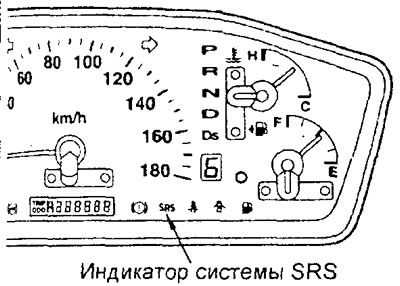Checking the SRS indicator
1. Turn the ignition key to position "ON" (ON) and check that the SRS indicator lights up.
2. Check that the SRS indicator lights up for about 7 seconds and then turns off and stays off for at least 5 seconds.
3. If the operation of the SRS indicator differs from the specified, then check the trouble codes.

Visual inspection of system components on the vehicle
Attention:
- − If defects are found during visual inspection of any of the indicated components of the system, replace the defective part.
- Failure to properly install any parts or assemblies of the SRS system may cause the SRS system to malfunction, resulting in serious injury or death to the vehicle driver and front seat passenger.
1. Preparation for testing.
Turn the ignition key to position "LOCK". Disconnect the wire from the negative battery terminal and insulate the connector of the disconnected wire.
Caution: After disconnecting the cable from the negative battery terminal, wait at least 60 seconds before proceeding with further work.
Warning labels
All elements of the vehicle's SRS system, as well as elements related to this system, have appropriate labels describing maintenance requirements. When servicing the SRS system, follow the instructions on the labels. If labels are damaged or dirty, replace with new ones.



2. Checking the SRS electronic control unit.
A) Check the SRS-ECU housing and brackets for dents, cracks, deformation, or corrosion.
b) Check the connectors and retainer for damage, deformation, and rust on the connector pins. Replace the SRS ECM if visual inspection reveals a defect.
3. Checking the driver's frontal airbag module and front passenger's frontal airbag module, steering wheel and coiled wire.
A) Remove the airbag modules, steering wheel and coiled wire.
Caution: Removed airbag modules should be stored in a clean, dry place with a protective pad (front side) up.
b) Check for dents, cracks or deformations on the surfaces of the airbag protective pads.
V) Check Status (no kinks or pinching) harnesses, no damage and deformation of connectors and their conclusions.
G) Check for dents, cracks, or deformations on inflatable bodies (gas generators).
d) Check the connectors and protective tubes of the coiled wire for damage and the terminals of the connectors for deformation.
e) Visually inspect for damage to the coiled wire housing.

and) Put the coiled wire in place (see related section).

h) Install the upper and lower steering column shrouds, steering wheel and driver front airbag module.
And) Check the ease of rotation and the absence of extraneous sounds when the steering wheel is turned.
To) Check steering wheel play.
